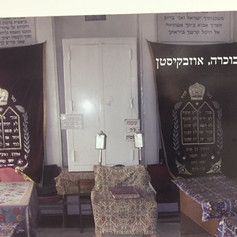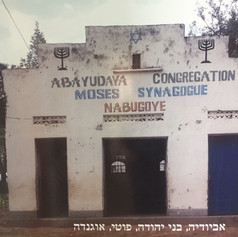A Senior Citizen Attending Yeshivah
- Rabbi Seth D Gordon
- Feb 21, 2018
- 5 min read
There is an energetic buzz in the Beit Midrash. Sixty or 70 students, nearly all in their early 20’s, are studying, usually in a chevruta, a partnership. One is talking and the other responds. It is the ancient and modern sound of Talmudic learning.
Suddenly, I am startled. Across the room I hear shouting. Why? What? Then I realize, it is a Talmudic student or two shouting in a give-and-take in chevruta. It is not the only startling noise I have heard in the yeshivah. At other times, a student or teacher will start singing impromptu, maybe a niggun, a wordless chassidic melody, not softly, but in a voice that can be heard across the room. At 60, I am not always happy about these decibel developments, because they interrupt my concentration. Do they have to yell? Are they not aware of others? Others seem unfazed by the outbursts. It is normal.
Then I recalibrate. This is a yeshivah. What is a yeshivah anyway? It is not a sterile university. It is where all sorts of people, many with superior intellects, and undoubtedly with religious commitment and passion, study and live and be. So I take a mental step back; I think of this coming generation of voices and I smile with contentment. The yeshivah is alive!
Even this relatively modern yeshivah is not a fancy place. I find the exterior attractive (see pics), but the interior is basic (though I do love the view through its windows). The walls are plain. The rooms are filled with desks, chairs, and books. There are books all over. Some rest semi-neatly in their shelves, waiting for the next hand to grab them, others relax at the desks of the students, still others lay piled on each other, on desks or on the window sills.
The classrooms are also plain: a teacher’s desk, desks for the students, plastic chairs, and shelves. (see pic) The dining hall has plain tables, and the food is set in an ordinary, functional serving stand (pic). Students take plain hard plastic plates and basic metal utensils from a rack; the appearance of the utensils reveals that they have been around for a while. Soup is served from a water jug (pic) I sometimes stay for lunch and the food is pretty good (recall my schnitzel story); but the building, aside from elements on the outside, lacks any glitz. Even the housing is basic. Many students live in “caravans,” meaning “trailers.” Simple and small. Basic.
By contrast, in American universities, the rooms have become fancier and fancier in an attempt to lure high school graduates and their parents. That is not to say that America does not produce some very good and great students, as does Israel and the yeshivot. But here glitz is a foe, a seducer of the other world. Here the audible voices of study reign.
The yeshivah does have one special physical feature. On its walls are 56 (I counted) pictures of synagogues across the world -- from Europe, Asia, North Africa, Africa, India (see pictures; Hebrew readers can phonetically discern many of the locations; others will have to wait for my return, or ask). It makes a statement about synagogues and Jewish history.
What is modern in the yeshivah is technology. One of the benefits of being among young adults is that they easily navigate the technological world. There are numerous text messages, photographs, and discussions in my “WhatsApp” app. Before coming to Israel I didn’t know much about “WhatsApp” -- I do now. I have also learned to find the right dictionary -- online, and an online library of Jewish texts. Our old reference books are largely irrelevant. I actually think I use technology in ways that the younger students don’t. I copy the texts onto my own file, and I can color code key phrases or use other features to emphasize points in the text. Sometimes we older folks have a few advantages.
It occurs to me: “I am living a young man’s life.” Of course, I am married with five children and two granddaughters and two more grandchildren on their way, but aside from Shabbat and an occasional encounter with my Israeli children and phone calls to the US, I am living singly, in a very modest apartment. I am in school with twenty-somethings. I am in the land of my people -- I feel young.
But not always. With my grey/white hair, I am one of the oldest students here, and I am one of the newest, having entered just weeks ago. I belong to no group, even though I am with the same class. (Most have been together here for about two years.) Gradually they have gotten to know me a bit. Several have asked me if I would lead some informal class on the American pulpit rabbi or American Jewry. It comes with 30+ years of rabbinical experience.
I am reminded of my age, when, as would be expected, most of the students know little of Israel’s hyperinflation of the 1980’s, when prices in the supermarkets changed at least twice daily, when highways were primitive one-laners, and when telephone installation (what’s that?) took many months.
I have my routine. Morning minyan @ 7:00, make breakfast, attend to some personal things, and, weather permitting, make that 25-minute walk to the Yeshivah. From 9:00 until 11:30 I prepare for Rav Boaz’s 11:30-1:00 class. But periodically when we have not finished the material he needs to complete, Rav Boaz calls for additional sessions, either at 9:30 or after lunch. On Sundays and Mondays there are extra classes at 3:00 on a related subject of Jewish legal concepts and philosophy.
After my walk back, until late at night, I still often have much to do: preparing class material, writing these blogs and divrei Torah, studying talmud for the siyyum (which overrides the fast for the first-born for Pesach), and doing other synagogue work through emails and calls. Minchah and arvit divide the latter part of the day. There are also evening and night calls and emails to and from family and members of Traditional, and more personal errands like food shopping, preparing dinner and cleaning up, etc. I also read those Israeli newspapers -- online. Like the yeshivah, my life is pretty plain and basic -- and I am very busy. I love it.
I thought I might take advantage of Israeli kosher restaurants. There has been too little time or, surprisingly, too little interest. I also had thought I might do a little supplementary learning -- and I have, but not much--not enough time.














































































Comments